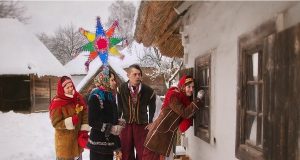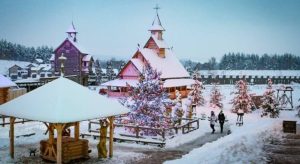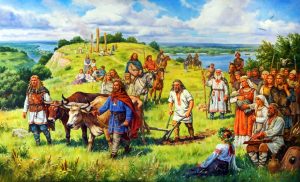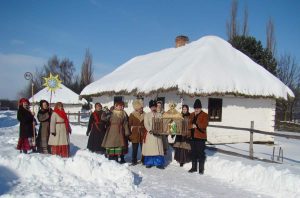Today, Ukrainians celebrate the New Year on the night of December 31 to January 1. However, this was not always like that: depending on the events, the dates changed, and even the seasons of celebration. So let’s make a short historical overview and find out how and why this holiday was celebrated on different calendar days.
“Spring” New Year in ancient times
Initially, the New Year for Ukrainians was a spring holiday. In ancient times, the celebration of the New Year coincided with the beginning of the nature revival, so it took place in March – this was when agricultural work started. Everything is simple: since winter has passed, the New Year has come.
There is no exact information on exactly how the New Year was celebrated in pagan times on the territory of Kyivan Rusʹ. But most sources claim that it was celebrated on the eve of the vernal equinox, calling it “New Summer”. The fact that March symbolized the beginning of a new year was also asserted by the ancient pagan custom of having a solemn dinner in honor of deceased relatives in March. At this time, Ukrainians eulogized the end of winter and performed the ritual of burning a straw scarecrow, symbolizing the close connection of nature with human life.
The March celebration of the New Year is also confirmed by the names of the months preserved today in the Romance and some Slavic languages. So, “October” (from lat. octo) – means the eighth month of the year, “November” (from lat. novem) – the ninth, December (December, from lat. decem) – the tenth.
March 1 in Kyivan Rusʹ
With the advent of Christianity in Ukraine and the introduction of the Julian calendar, March 1st officially became the New Year’s Day. It is this date, according to church canons, that coincides with the date of the world’s creation. Among the people, March 1 according to the old calendar (and March 14 according to the new one) is the day of the venerable martyr Yevdokiia. According to folk beliefs, this is the first day of spring, which means the first day of the New Year.
During the times of Kyivan Rusʹ, there were no special celebrations of the New Year. Primarily all activities were aimed at calling for well-being in the following year. At this time, gardeners sow seedlings of cabbage and other crops in the hope that the plants will not be afraid of frost and will give a generous harvest.
September 1 in the 15th century
In the 15th century, the church adopted the Greco-Byzantine church rite. According to it, the New Year began on September 1st. This decision was motivated by the fact that at that time, Jesus Christ began to teach the divine doctrine, which meant the fulfillment of the Old Testament’s prophecies and the New Testament’s beginning. From September 1st to 8th, the first sermon of Jesus took place.
Since then, on September 1st (or September 14th according to the new calendar), our ancestors celebrated the day of St. Simeon the Stylite, which meant the arrival of the New Year. On this day, all rural craftsmen got to work.
With the introduction of a new chronology system – the Gregorian calendar, all European nations switched to celebrating the New Year on January 1st. The Orthodox Church initially recognized the inaccuracy of the old Julian calendar but did not switch to the Gregorian. The reason was that, according to the Gregorian calendar, the Christian Easter sometimes coincides with the Jewish one or comes earlier, which is prohibited by the “Apostolic Canons”.
January 1 after 1700
In 1582, Pope Gregory XIII introduced a new calendar called the Gregorian. The introduction of the so-called new style is associated with these events. According to it, Christian countries began to switch to celebrating the New Year on January 1st.
It is believed that since 1700 this tradition has come to the territory of modern Ukraine. This was preceded by a trip of Peter I to the countries of Western Europe, from where he brought a lot of ideas and began to implement them gradually. One of the innovations was transfering of the celebration of the New Year to January 1st.
However, since the church continued to adhere to the Julian calendar until 1918, the celebration dates did not coincide in all Ukrainian lands. As a result, two holidays were formed in Ukraine – New Year (January 1) and Old New Year (January 14).
Today, Ukrainians held loud celebrations of the New Year and all preceded by large-scale preparations. Ukrainians choose gifts for loved ones, decorate their homes, prepare a festive table, and follow other traditional rituals. This is a popular and very favorite holiday among adults and children.









